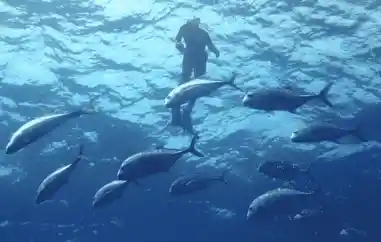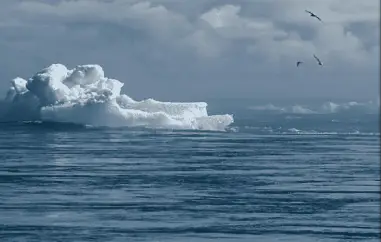The Mysteries of the Deep Sea: Exploring Earth's Final Frontier
 The deep sea, often referred to as Earth's final frontier, holds a world of mysteries and wonders waiting to be explored. Covering over 70% of the planet's surface, the ocean remains largely uncharted and unexplored. Despite advances in technology, only about 20% of the ocean floor has been mapped, leaving the vast majority hidden in the darkness of the deep. This article delves into the fascinating and enigmatic world of the deep sea, revealing its unique ecosystems, strange inhabitants, and the challenges faced by scientists in uncovering its secrets.
The deep sea, often referred to as Earth's final frontier, holds a world of mysteries and wonders waiting to be explored. Covering over 70% of the planet's surface, the ocean remains largely uncharted and unexplored. Despite advances in technology, only about 20% of the ocean floor has been mapped, leaving the vast majority hidden in the darkness of the deep. This article delves into the fascinating and enigmatic world of the deep sea, revealing its unique ecosystems, strange inhabitants, and the challenges faced by scientists in uncovering its secrets.
The Unfathomable Depths
The ocean is divided into different zones based on depth and light penetration. The epipelagic zone, or sunlight zone, extends from the surface to about 200 meters deep and is where most marine life is found. Below this lies the mesopelagic zone, or twilight zone, which reaches depths of up to 1,000 meters. Beyond this, the bathypelagic zone, or midnight zone, plunges to 4,000 meters, followed by the abyssopelagic zone, extending to 6,000 meters. Finally, the hadalpelagic zone, found in deep ocean trenches, can reach depths of over 11,000 meters.
In these extreme environments, sunlight does not penetrate, and the pressure is immense. For instance, at the bottom of the Mariana Trench, the pressure is over 1,000 times greater than at sea level. Despite these harsh conditions, life thrives in the deep sea, exhibiting extraordinary adaptations to survive.
Strange and Wonderful Creatures
The deep sea is home to some of the most bizarre and otherworldly creatures on Earth. Bioluminescence is a common feature among deep-sea organisms, providing them with a means of communication, camouflage, and predation. The anglerfish, for example, uses a bioluminescent lure to attract prey in the pitch-black depths. This fascinating fish has a long, protruding spine with a light-producing organ at the tip, which it dangles in front of its mouth to entice unsuspecting victims.
Another remarkable deep-sea inhabitant is the vampire squid, which derives its name from its dark color and cloak-like webbing between its arms. Unlike its bloodthirsty namesake, the vampire squid feeds on marine snow--organic debris falling from the upper layers of the ocean. It uses filamentous appendages to capture these particles, showcasing a unique adaptation to the scarce food resources in its environment.
Deep-sea gigantism is another intriguing phenomenon, where certain species grow to enormous sizes compared to their shallow-water relatives. The giant squid, for instance, can reach lengths of up to 43 feet. This adaptation is thought to be a result of the cold temperatures and high pressures of the deep sea, although the exact reasons remain a topic of scientific debate.
Exploring the Abyss
Exploring the deep sea is no small feat. The extreme conditions pose significant challenges, requiring advanced technology and robust equipment. Submersibles, remotely operated vehicles (ROVs), and autonomous underwater vehicles (AUVs) are essential tools for deep-sea exploration. These vehicles are designed to withstand the crushing pressures and navigate the dark, rugged terrain of the ocean floor.
One of the most notable achievements in deep-sea exploration is the descent of the bathyscaphe Trieste into the Mariana Trench in 1960. Piloted by Jacques Piccard and Don Walsh, the Trieste reached a depth of nearly 11,000 meters, marking the deepest manned dive in history. More recently, filmmaker James Cameron made a solo dive to the bottom of the Mariana Trench in the submersible Deepsea Challenger in 2012, further advancing our understanding of the deep sea.
Despite these achievements, much of the deep ocean remains unexplored. The vastness and inaccessibility of this environment mean that new discoveries are constantly being made. From unknown species to underwater volcanoes and hydrothermal vents, the deep sea holds countless secrets waiting to be uncovered.
The Importance of Deep-Sea Exploration
Understanding the deep sea is crucial for several reasons. It plays a vital role in regulating the Earth's climate, as the ocean absorbs and stores large amounts of carbon dioxide. Deep-sea currents also drive global ocean circulation, distributing heat and nutrients around the planet. Moreover, deep-sea ecosystems are rich in biodiversity and could hold the key to new medical and technological advancements.
However, the deep sea is not immune to human impact. Pollution, overfishing, and climate change threaten these fragile ecosystems. Deep-sea mining, in particular, poses a significant risk, as it involves extracting minerals from the ocean floor, potentially disrupting habitats and releasing toxic substances.
In conclusion, the deep sea remains one of the most intriguing and least understood regions of our planet. Its exploration not only satisfies our curiosity but also provides invaluable insights into the Earth's processes and the incredible adaptability of life. As technology continues to advance, we can look forward to uncovering more of the deep sea's mysteries, ensuring that we appreciate and protect this final frontier for generations to come.












































